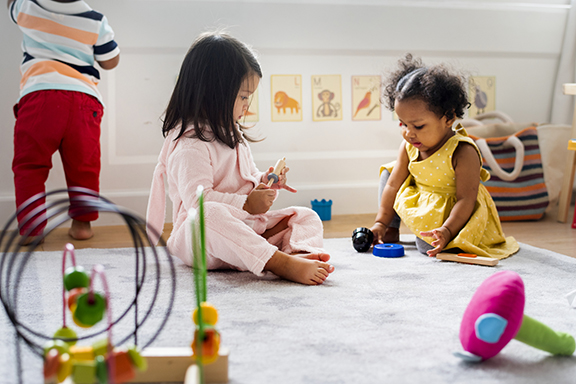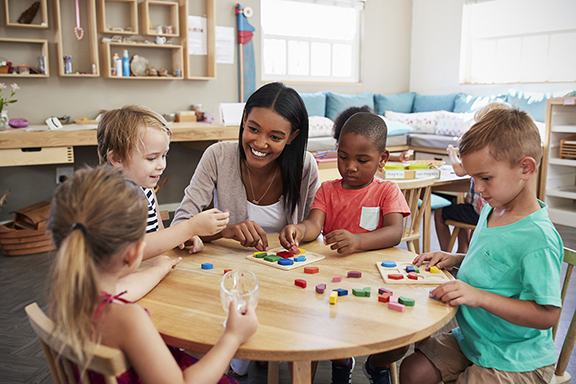How to Use the “I Do, We Do, You Do” Model to Build Emotional Well-Being in Teens

Amanda Morin
Former Vice President Learning and Knowledge, Jed Foundation (JED)
We know that connection and a sense of belonging are the keys to teens’ emotional well-being. Seeking out connection and support can be difficult for teens, but in a time when the U.S. Surgeon General has declared loneliness an epidemic, it’s also critical.
Successfully building connections, recognizing and reducing stress and feelings of isolation requires a strong sense of self-awareness and positive self-esteem. Achieving self-awareness and self-esteem involves being able to understand and recognize emotions, knowing what you care about, and identifying how you view and value yourself. But developing these skills is an internalized process.
No matter how badly we might want to do it for our teens, we can’t. What we can do, though, is provide them with the tools to develop these skills. That’s not just important as they move toward adulthood, it’s also essential so that they’re able to openly talk about and address the effects of loneliness and isolation on their mental and emotional well-being.
Gradually Shifting Responsibility: I Do, We Do, You Do
The skills required to recognize and reduce stress, talk openly to others about their mental health and well-being, and build meaningful connections don’t develop all at once. It requires scaffolded teaching (working in phases) to gradually shift the responsibility from you to your teen.
Using the “I Do, We Do, You Do” model, a strategy developed by Doug Fisher and Nancy Frey gives you a way to eventually become the safety net underneath your teen instead of the shielding umbrella above them.
Here’s how it works:
In the I Do stage, you explain what your teen needs to understand or show them how you’d approach the situation and how to use a particular skill.
In the We Do stage, you help your teen by being available to talk them through how to approach the situation, or to prompt in appropriate ways, such as providing a script for them to follow during a phone call.
In the You Do stage, your teen does it on their own or talks you through how they’d handle a situation. (You may want to debrief afterward to make sure they feel confident they understand the skill.)
Here are some of the important skills that will help teens manage stress, build social connections, and begin to have conversations about mental health—and how to teach them using the “I Do, We Do, You Do” framework.
Recognizing and naming stressors
It’s common to confuse stress and anxiety. Knowing the difference between the two is an important start in helping teens know when something is stressing them out or if it’s causing them true anxiety. Stress is something we all experience and a word that gets thrown around a lot at home, in school, and online. There’s academic stress, financial stress, stress about relationships, and even climate-related (or eco-) stress. For the most part, stress is usually caused by something external that causes you to worry—like an upcoming test or an audition for the school play. Ideally, the stress motivates you to study or practice, and then the moment comes, you get through it, and the stress is relieved.
Anxiety, on the other hand, is usually more constant and out of proportion to the situation. Maybe your teen didn’t get the grade they were hoping for on a test, and they can’t stop thinking about it or assume it means the worst will happen—they will fail their class. When teens are living with anxiety, their worries take up a lot of mental real estate and get in the way of their day-to-day life.
When stress becomes constant, it can lead to anxiety, which is why recognizing and identifying the causes of stress is so important.
I do: Have a conversation with your teen when you’re stressed and point out what they might notice. That might sound like, “You may have noticed I keep talking about this big project I have at work and am a little distracted. I realized I’m really stressed about meeting the deadline. I just wanted to say it out loud because I want you to know I’m recognizing it’s affecting me. That helps me change how I’m dealing with it and know that it will pass.”
We do: Begin by having a conversation with your teen when they seem stressed. Point out what you notice, ask them to think about what’s going on, and then help them brainstorm their stressors. That might sound like, “I notice you’re talking a lot about how stressed you feel. You do seem kind of distracted. Does that match how you feel? What do you think is causing you stress?”
You do: When your teen is stressed, you can remind them that they have the skills to recognize their own patterns of stress and identify what might be causing it. You may also want to just check in. That can sound as simple, “How are things going lately? I was wondering if talking about stress and how to recognize it was helpful.”
Practicing mental fitness
Emotional health is no different than physical health and, just like doing things to stay physically fit, there are things you can do regularly to build mental fitness, too. When you build mental fitness and are able to have more of an awareness of how you think, behave, and feel, you’re also building the ability to manage life challenges with more emotional flexibility. You know that feeling when your teen says something that bothers you and you make a snappy comment before you can stop yourself? Mental fitness helps you pause and respond in the way you wish you had in the moment, instead of being reactive.
It’s a tool that allows you to proactively support your own well-being as well as teaching your teen to handle setbacks, reset in high-stress moments, and get in touch with—and do—things that help them feel good and emotionally healthy.
I do: Talk to your teen about building emotional health using the analogy above and then share the things you do to build your own mental fitness (or the things you want to start doing). For instance, you may tell your teen you’re going to take 15 minutes every day to read a book for fun.
We do: Share with your teen ideas that you might have for them to use to build emotional fitness. The key in this stage is to listen to their feedback. That might sound like, “Yeah, that does sound like a suggestion that would work for me, but not for you. Tell me what you’d like to do instead.”
You do: Notice when your teen is using the skills and tools you brainstormed and take the opportunity to check in. That can sound like, “I notice you’re [insert skill/activity] more. How’s that going?”
Having conversations about mental health
It can be much harder to talk about mental health than it can be to talk about physical health. It’s not unusual to hear people talk about how rundown they feel when they have a cold, or how they need to avoid certain foods that might trigger an allergic reaction, but it’s not as typical to hear people talk about feeling too mentally exhausted to get out of bed or needing to avoid environments that cause them anxiety. Traditionally, there’s been more stigma around talking about mental health challenges. People feel ashamed when they’re the one struggling or they may not know how to react when somebody else is.
The good news is that teens are talking more openly about mental health in general, so helping them learn to talk about it on a more personal level may be easier than you think, and using the medical analogy can help.
I do: Be genuine, up front, and honest that you want to start having conversations about mental health. That can sound like, “I know we haven’t talked about this that often, but I want to talk about it more so I can support you in anything you need help with, and so you feel comfortable knowing how to have these conversations not just with me, but with other people, too. Can we talk about how things are going for you?”
We do: Initiate a mutual check-in so that you and your teen can both practice having the conversation. That may sound like, “I thought it would be good to check in on each other. I’ll start: On a scale of 1 to 10—with 1 being that I’m struggling to get out of bed each day and 10 being that my mental health is really good—I’m at about 7 right now. But there’s nothing specific I need anybody’s help with because that’s pretty typical for me. How are you doing? ”
You do: Remind your teen that you’re not the only person they can have this conversation with, and encourage them to check in on, or with, a friend. You may want to let them know that it can be easier to have conversations about mental health if you have them regularly and not just when someone is struggling.
Building social connections and finding your people
Building connections and making friends can be difficult at any age. It can be particularly challenging in the teen years when people are still figuring out who they are and trying out different identities. One thing teens may not yet have learned is that they can have different types of friendships and connections with different people.
For instance, it’s OK to have people who they hang out with just at school. It’s OK to be friends with someone who is a lot of fun or someone who has similar interests, but may not be a friend they can talk to about their feelings. Part of growing up emotionally is being able to manage these different levels of emotional closeness and figuring out what level of closeness is reasonable in different situations or relationships.
Helping your teen understand that even if someone may not be a “forever friend,” there’s value to the friendship, is a good start to helping them learn how to build connections.
I do: You also have an opening to talk about building connections when your teen sees you interacting with people you know. Your teen may notice that your posture, tone of voice, and word choice varies depending on who you’re talking to. These situations give you a chance to talk to your teen about what kinds of connections you have—acquaintances, close friends, work friends, and so on, and discuss what the equivalent would be in their life.
We do: When your teen talks to you about problems with their friends (or a worry about not having friends), it’s a good time to explore with your teen what they value in a friend and what they want from a friendship. That can sound like, “What are some important traits for your friends to have? Do you want to be friends with someone fun? Reliable? Easy to talk to? Something else?” The conversation may challenge your teen to think more critically about what “connection” means to them.
You do: Help your teen recognize when they’ve made those positive connections by saying things like, “I notice you’re spending more time with [name]” or “I hear you talking about [name] a lot lately.” If they’re still struggling to build connections, remind them that it’s OK not to have a crowd of friends and that friendships can change and develop over time.
Ultimately, we want our teens to feel mentally healthy, safe, and comfortable in the spaces they inhabit and with the people around them. Using the “I Do, We Do, You Do” framework to help them build the skills to seek out the connection and support gives us—and our teens—a way to become more confident and competent young adults.
Resources
Check out these “10 Tips for Talking to Your Teen About Mental Health” at https://jedfoundation.org/?s=10+Tips+for+Talking+to+Your+Teen+About+Mental+Health
Fisher, Douglas, and Nancy Frey. “Homework and the Gradual Release of Responsibility: Making ‘Responsibility’ Possible.” The English Journal, vol. 98, no. 2, 2008, pp. 40-45. JSTOR, http://www.jstor.org/stable/40503381. Access 11 June 2023.
Amanda Morin is an educator and former Vice President, Learning and Knowledge, Jed Foundation (JED), a nonprofit dedicated to protecting and promoting emotional health for teens and young adults.
This article appeared in the 2024 issue of the Parents League Review. Get the current issue of the Review free with a family membership. Or purchase it separately.











